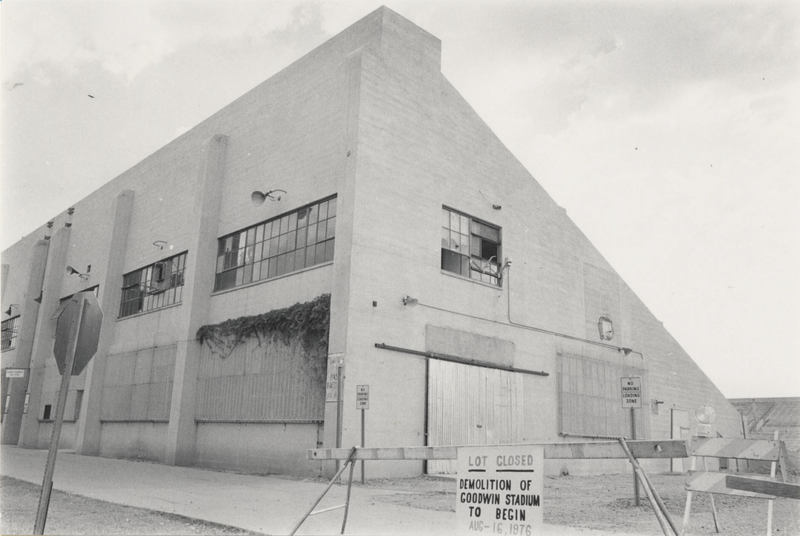
The games played during Goodwin Stadium's 19 years as ASU's football stadium would have profound consequences and shape the identity of the school.
Arizona State University's football program grew dramatically from the first sparsely-attended football games played at Goodwin Stadium to the packed Sun Devil Stadium. It grew in tandem with Arizona State Teachers College (ASTC) as it matured into a full-fledged university. Goodwin Stadium bore witness to that growth. Completed in 1936 for $87,000, the stadium was originally just a set of bleachers with only 5,000 seats. The team playing at Goodwin Stadium was not the Sun Devils of ASU; they were the Bulldogs of Arizona State Teachers College. Over the 19 years that the stadium was used for football, the school saw drastic changes that helped shape ASU into what it is today.
The late 1930s saw the football program start to win as it had never before, and the program also became more diverse, heralding the future of sports in America and the University. The team only won 7 games during its first three years at Goodwin. However, the 1939 team won 8 games and finished the season with a tie in the program's first Bowl Game. The late 1930s also brought about change with the addition of Emerson Harvey. Harvey was the first Black football player, and only the second Black athlete, in school history. Not only did Harvey excel on the field, but also he was fundamental in breaking down barriers on campus. He helped break color barriers across the southwest as many teams, especially in Texas, had never played against Black athletes.
After struggling in the 1940s, the ASTC Bulldogs morphed into the Sun Devils. During World War II, the school did not field a team, as was the case at many universities across the United States. When football returned after the war, it was not pretty. In 1946, the team went 2-7 and suffered the most humiliating defeat in the school's history: a 67-0 blowout against Arizona. As fan frustration grew, some boosters wanted to give the team a fresh new look. The Bulldog's boosters and other groups formed the Sun Angels, an organization devoted to improving ASTC athletics. They suggested that the school's teams should be called the Sun Devils. After a student body vote, the name was adopted in 1946. The school's mascot, Sparky, was created two years later by a former Disney employee, Berk Anthony. It was rumored that Anthony modeled Sparky after Walt Disney himself.
In the 1950s, the program started to turn a corner as it
revamped its rivalry with the University of Arizona (U of A). The Sun Devils had a terrible record against their in-state rivals in previous years. U of A held a 20-2 advantage over ASTC and hadn't lost a game to them in 18 years. The rivalry was renewed when ASTC clobbered the Wildcats 34-7 at Goodwin Stadium. Between 1949 and 1957, the Sun Devils beat U of A five times. In 1955, Frank Kush came to the University as an assistant coach. When he first saw Goodwin Stadium, he thought, "God Almighty—this is it?" The stadium was just two bleachers with a field that seated 15,000. Compared to the stadiums at higher-profile schools, Goodwin was an afterthought.
Kush would lead the Sun Devils as both the team and the University rose together like a phoenix from the ashes of Goodwin Stadium, which was demolished in 1957. Slated to be replaced by a bigger stadium, built into the Hayden Butte, Goodwin had one last hurrah as the Sun Devils finished with their first perfect season at 10-0. Another first for the football team was getting ranked in the AP poll. The team finished the season ranked #12 in the country. The year's final game would go down as possibly the most critical game in Sun Devil history when the Sun Devils defeated the Wildcats 47-7. This victory and perfect season generated excitement and augured Arizona State University's subsequent great triumph. In 1958, the University promoted a ballot initiative as to whether Arizona Teacher's College could become a full-fledged university on par with the University of Arizona. Overcoming vigorous lobbying by the University of Arizona, the ballot measure passed by a 2-1 margin. Some believed that the previous season's football victory had had an impact on legitimizing Arizona State. Sun Devil Stadium would take over the following year for Goodwin, and Frank Kush would become the new head coach. Kush led the team to new heights and constant national recognition. Still, without the teams that played on the field at Goodwin, ASU might never have reached these accomplishments.
edited 10/20/22: js
Images




Date: 1940s


